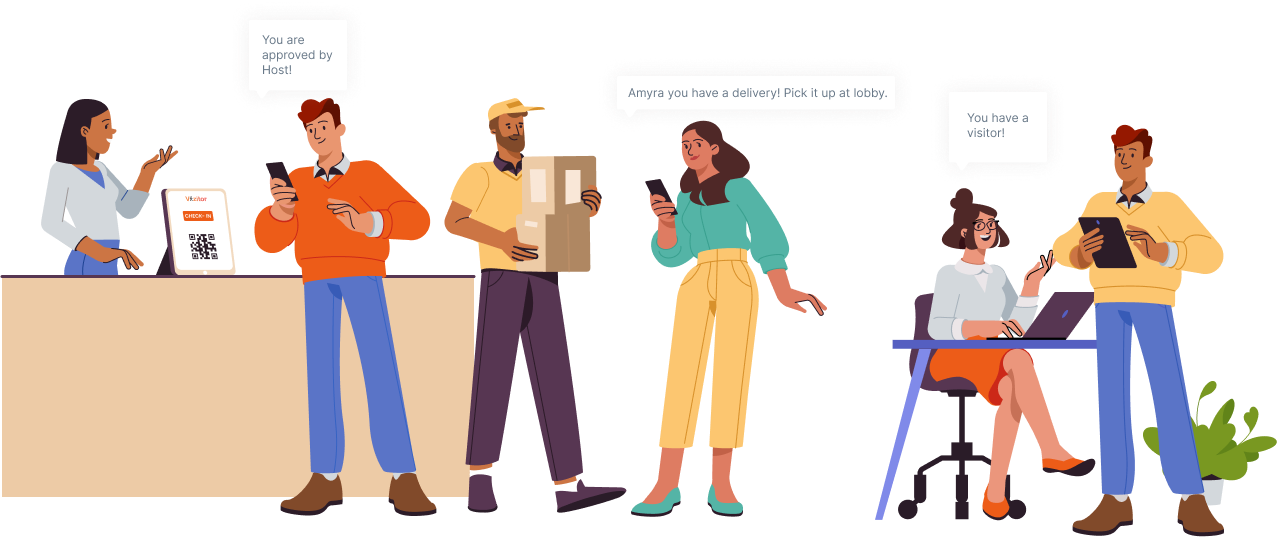Table of Content
Try Vizitor for Free!

Thu, May 23, 2024
Read in 9 minutes
Did you know that the modern workplace has undergone a transformative shift, thanks to advancements in technology? Today, businesses across industries are leveraging cutting-edge tools and digital solutions to enhance productivity, collaboration, and efficiency like never before. This era of modern workplace technology has brought about significant changes, shaping the way we work, communicate, and innovate.
The International Data Corporation (IDC) predicts that global spending on digital transformation technologies will reach $2.8 trillion by 2024, reflecting the widespread adoption and investment in modern workplace solutions.
Cloud-based platforms like Microsoft 365 and Google Workspace have revolutionized how teams collaborate, store data, and access applications from anywhere, enabling seamless remote work and scalability.
The Era Of Modern Technology In Workplace
The journey of modern workplace technology has been a fascinating evolution, driven by pioneering minds and transformative innovations. From the advent of the personal computer to the sophisticated digital ecosystems we navigate today, technology has continually reshaped the way we work.
1. The Beginnings: The Personal Computer Revolution
The era of modern workplace technology began in earnest in the 1970s and 1980s with the introduction of personal computers (PCs). Companies like IBM and Apple played pivotal roles in this transformation. IBM’s launch of the IBM 5150 in 1981 and Apple’s introduction of the Macintosh in 1984 brought computing power to the desks of ordinary employees, revolutionizing productivity and accessibility.
2. The Rise of the Internet and Networked Workplaces
The 1990s saw the rapid expansion of the internet, fundamentally changing the workplace landscape. The development of the World Wide Web by Tim Berners-Lee in 1989 and the subsequent rise of web browsers like Netscape Navigator enabled businesses to connect and communicate like never before. Email became a standard tool for communication, and intranets facilitated internal collaboration.
3. The Advent of Mobile Technology
The early 2000s ushered in the age of mobile technology. The introduction of smartphones, particularly the launch of the iPhone by Apple in 2007, transformed how employees accessed information and communicated on the go. Mobile applications and cloud computing solutions began to proliferate, allowing for remote work and real-time collaboration.
4. Cloud Computing and Collaboration Tools
The late 2000s and early 2010s marked the rise of cloud computing. Services like Amazon Web Services (AWS), Google Cloud, and Microsoft Azure enabled businesses to store and process data over the internet, reducing the need for on-premises infrastructure. Collaboration tools such as Google Workspace (formerly G Suite) and Microsoft 365 became essential for team collaboration, document sharing, and project management.
5. Artificial Intelligence and Automation
In recent years, artificial intelligence (AI) and automation technologies have taken center stage. AI-powered tools like chatbots, virtual assistants, and machine learning algorithms are automating routine tasks, providing insights from data, and enhancing decision-making processes. Companies like IBM with Watson and Google with its AI research are leading the charge in this domain.
6. The Impact of the COVID-19 Pandemic
The COVID-19 pandemic accelerated the adoption of modern workplace technologies. Remote work became a necessity, pushing organizations to rely heavily on digital tools. Video conferencing platforms like Zoom, Microsoft Teams, and collaboration tools became indispensable. The pandemic underscored the importance of flexibility, resilience, and the capability of technology to maintain business continuity.
The Current State and Future Trends
Today, modern workplace technology is characterized by an interconnected ecosystem of devices, applications, and platforms designed to enhance productivity, communication, and collaboration. Key trends shaping the future include:
• Hybrid Work Models: Combining remote and in-office work to provide flexibility and optimize productivity.
• IoT and Smart Workspaces: Leveraging Internet of Things (IoT) devices to create intelligent, responsive work environments.
• Advanced Cybersecurity: Enhancing security measures to protect against increasingly sophisticated cyber threats.
• Virtual and Augmented Reality: Transforming training, meetings, and collaborative projects through immersive experiences.
Benefits of Technology in the Workplace
Modern workplace technology has become a cornerstone of the modern workplace, driving efficiency, collaboration, and innovation. Here are some of the key benefits technology brings to the workplace:
1. Increased Productivity
• Automation tools and software streamline routine tasks, freeing up employees to focus on higher-value activities.
• Project management tools like Asana and Trello help teams organize tasks, set deadlines, and track progress, enhancing overall productivity.
2. Enhanced Communication and Collaboration
• Communication platforms such as Slack, Microsoft Teams, and Zoom facilitate real-time communication and virtual meetings, breaking down geographical barriers.
• Collaboration tools like Google Workspace and Microsoft 365 allow multiple users to work on documents simultaneously, improving teamwork and efficiency.
3. Flexibility and Remote Work
• Cloud computing and mobile technology enable employees to access work-related files and applications from anywhere, promoting remote work and flexible schedules.
• Remote work tools ensure that employees can maintain productivity and connectivity regardless of their location.
4. Improved Data Management and Analytics
• Advanced data management systems and analytics tools help businesses collect, store, and analyze large volumes of data, leading to better decision-making and strategic planning.
• Business intelligence tools like Tableau and Power BI provide insights through data visualization, helping organizations make informed decisions.
5. Cost Savings
• Technology can reduce operational costs by automating repetitive tasks, minimizing errors, and optimizing resource utilization.
• Cloud-based solutions eliminate the need for expensive on-premises infrastructure and maintenance costs.
6. Enhanced Customer Service
• Customer relationship management (CRM) systems like Salesforce and HubSpot enable businesses to manage customer interactions, track sales, and provide personalized service, improving customer satisfaction and loyalty.
• AI-powered chatbots and virtual assistants offer 24/7 customer support, handling routine inquiries and freeing up human agents for more complex issues.
7. Better Security
• Advanced cybersecurity solutions protect sensitive data and systems from cyber threats, ensuring the integrity and confidentiality of business information.
• Technologies like encryption, multi-factor authentication, and intrusion detection systems enhance overall security.
8. Scalability and Growth
• Cloud-based services and scalable IT solutions allow businesses to grow and adapt their technology infrastructure according to changing needs without significant capital investment.
• As businesses expand, technology supports seamless scaling of operations, from adding new users to increasing storage capacity.
9. Improved Employee Engagement and Satisfaction
• Technology can enhance the employee experience by providing tools that facilitate easier communication, collaboration, and access to information.
• Employee engagement platforms and HR software streamline processes like onboarding, training, and performance management, contributing to higher job satisfaction and retention rates.
10. Innovation and Competitive Advantage
• Staying up-to-date with the latest technology trends enables businesses to innovate and stay ahead of the competition.
• Technologies like artificial intelligence, machine learning, and IoT open new opportunities for creating innovative products, services, and business models.
How to Implement New Technology in the Workplace?
Implementing modern workplace technology involves several steps to ensure a smooth transition and maximize its benefits. Here’s a guide on how to do it effectively:
1. Assess Needs and Goals
• Identify areas where new technology can improve efficiency, productivity, or address specific challenges.
• Set clear goals and objectives for implementing the technology, such as cost reduction, better customer service, or streamlined processes.
2. Research and Select the Right Technology
• Conduct thorough research on available technologies that align with your needs and goals. Consider factors like cost, scalability, compatibility with existing systems, user-friendliness, and vendor support.
• Involve relevant stakeholders, such as IT experts, department heads, and end-users, in the selection process to gather diverse perspectives.
3. Create a Detailed Implementation Plan
• Develop a comprehensive plan that outlines timelines, responsibilities, budget considerations, and training requirements.
• Define key milestones and performance metrics to track progress and measure success.
4. Provide Training and Support
• Offer training sessions for employees who will use the new technology, focusing on its features, functionality, and best practices.
• Provide ongoing support and resources, such as user manuals, FAQs, and helpdesk assistance, to address any issues or questions that arise.
5. Pilot Testing and Feedback
• Conduct pilot tests with a small group of users to identify potential issues and gather feedback on usability and performance.
• Use feedback to make necessary adjustments and improvements before full-scale implementation.
6. Communicate Effectively
• Keep employees informed about the purpose, benefits, and impact of the new technology on their roles and the organization.
• Address any concerns or resistance to change through transparent communication and by highlighting the advantages for individuals and teams.
7. Monitor and Evaluate
• Continuously monitor the use of the new technology and gather feedback from users and stakeholders.
• Evaluate its impact on key performance indicators (KPIs) and compare results against predefined goals to assess its effectiveness. Make refinements or updates as needed to optimize performance and achieve desired outcomes.
8. Celebrate Success and Iterate
• Acknowledge and celebrate milestones and successes achieved through the implementation of new technology.
• Use lessons learned and feedback to iterate and improve processes for future technology implementations.
Wrapping It Up
The benefits of modern workplace technology are vast and transformative, affecting every aspect of business operations. By using the right tools and solutions, organizations can improve efficiency, drive innovation, and achieve sustainable growth. As technology continues to evolve, the potential for further enhancements in the workplace will only increase, offering new ways to optimize performance and deliver value.
Vizitor, a cutting-edge visitor management system, can revolutionize the way you manage and track visitors in your workplace. By automating the check-in process, Vizitor ensures a seamless and secure entry for guests, eliminating the need for manual logbooks and reducing administrative burden. With features like digital badges, pre-registration, and real-time notifications, Vizitor enhances security by providing instant visibility and control over visitor movements.
Additionally, the system’s integration capabilities with access control and other enterprise solutions streamline operations and improve data accuracy. By implementing Vizitor, you not only enhance the visitor experience but also boost overall efficiency and security in your workplace.
Frequently Asked Questions
1. What Is The Positive Impact of Technology in the Workplace?
Technology in the workplace boosts productivity and efficiency by automating tasks and enhancing communication and collaboration, resulting in a more streamlined and effective work environment.
2. How can new technology improve employee engagement and satisfaction?
New technology enhances employee engagement and satisfaction by simplifying communication, streamlining workflows, and offering greater flexibility. Tools like collaboration platforms, project management solutions, and remote work options empower employees to work efficiently and feel more connected, boosting job satisfaction and morale.
3. What are the potential challenges of implementing new technology in the workplace?
Implementing new technology can be challenging due to resistance to change, high costs, and complex integration. Clear planning, thorough training, and employee involvement are essential to overcome these hurdles.










